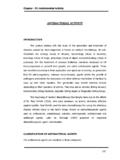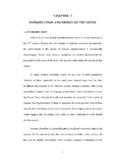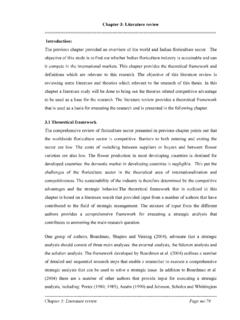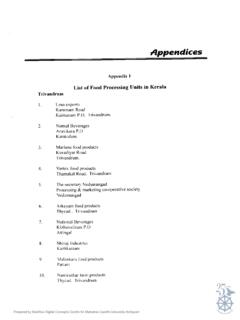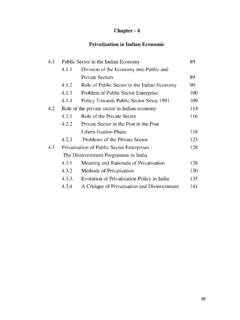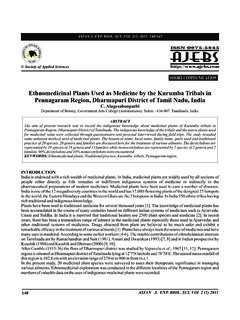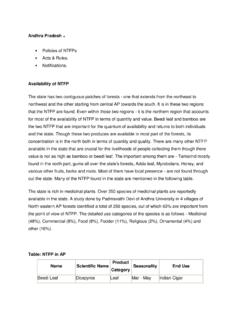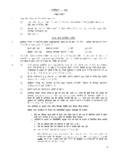Transcription of REVIEW OF LITERATURE CHAPTER - 2 - Shodhganga
1 Ethnobotany in relation to health and livelihood security in district Bastar of Chhattisgarh State. CHAPTER - 2. REVIEW OF LITERATURE . CHAPTER - 2. Ethnobotany broadly means, all aspects of direct relationship of plants with man, according to Cotton (1996) it's the study of all forms of vegetation used by aborigines. Man has been using flora and fauna since time of his emergence on this planet. He gained the knowledge of useful and harmful plants. This knowledge becomes an integral part of his culture. Studies in archaeology, paleobotany, and ethnography revealed the close relationship between plants and man. In India 2000- 1000 BC mentions are there in Rig-Veda and Atharveda about the uses of plants. Since then man knows the importance of plants. Ethnobotany is a rapidly expanding science.
2 In last three decades, it has been considerably expanded, both in its concepts and scope. Beginning with the study of plants used by tribals for food, medicine, and shelter, now it includes studies like conservational practices of tribals, ethnopharmacology, ethnopharmacognosy, ethnomusicology, ethnogynaecology etc. The LITERATURE on the subject is piling up at a very rapid rate; hence, an attempt has been made to include REVIEW of recent LITERATURE relevant to the present work. In this CHAPTER REVIEW of LITERATURE is done under the following headings:- Ethnobotanical work in India and Abroad: Ethnobotanical work in India was done by several workers like Jain (1963, 1963 b, 2006) on ethnobotany of India, Brijlal (1993) on Baiga of Madhya Pradesh, Sharma (1988), Sharma and Singh (1988), Roy (1989), Masih (1990) in Bastar, Kumar and Jain (1998) in Surguja, Chhattisgarh, Dagar (1989, 2000) on Onge tribe of Little Andaman, Dam and Hajra (1981) in Arunachal Pradesh, Ghosh (1986).
3 In West Bengal, Jain (1963), Bhatnagar (1973), Lal (1988), Saxena (1986), Maheshwari (1990), Bhall (1992), Maheshwari (1996), Oommachan (1990), Jain (1992), Jain and Sharma (1992), Mishra and Tiwari (1999), Shrivastava (1999), Yadav and Mishra (2001), Jharia (2006) on tribes of Madhya Pradesh, REVIEW of LITERATURE 23. Ethnobotany in relation to health and livelihood security in district Bastar of Chhattisgarh State. Joshi (1982), Sebastiean (1985), Joshi (1995), Jain (1997), Singh and Pandey (1998). on Ethnobotany of Rajasthan, Kamble and Pradhan (1980), Sharma and Narsimahan (1986), Pandey (1992), Tiwari and Padhye (1993) in Maharashtra, Megoneitso and Rao (1983), Rao (1990) in Nagaland, Prakas and Singh (2000) in Uttar Pradesh, Negi and Pant (1990) in Himachal Pradesh, Rajendra and Henry (1994), Subramani (2000) in Tamilnadu, Rao and Neogi (1980) in Meghalaya, Singh and Anand (1996).
4 In Uttar Pradesh. Sinha (1986) in Manipur, Tarafdar (1986), Thakur (1992) in Bihar, Upadhyay and Chauhan (2000) in Andhra Pradesh, Bennet (1983) in Sikkim, Hansha (2002) in Karnataka. Jain and Dam (1979) in north eastern India, Ammal and Prasad (1984) worked on Costus speciosus of Kanikkars of Tamilnadu. Islam (1999) studied the ethnobotany of asteraceous plant. Ford (1978) wrote a paper relating Anthropology to ethnobotany with title Ethnobotany Historical Diversity and Synthesis. In abroad, significant contribution in the field of Ethnobotany was done by workers like Duke (1970) who wrote ethnobotanical informations of Choco Indians. Dennis (1988) studied the herbal medicine among the Miskito of Eastern Nicaragua. Galeano (2000) investigated the forest use of Pacific Coast of Chococlombia, Gogai and Borthakur (1990b) classified ethnic plants of Tai communities.
5 Islam (1999). studied the ethno-botany of Majuli the great freshwater river island. Huyin (2000) compared the ethno-botany of Lahu people of China & Thailand. Kambizi and Afolayn (2001) studied the use of plants in sexually transmitted disease in Zimbabwe. Hilaly (2003) worked on economic evaluation of medicinal plants in Northern Morocco. Joshi and Edington (1990), Chhetri and Devakota (2007) investigated the plants of ethnobotanical importance in Nepal. Tilahun and Mirutse (2010) studied the wild edible plants of Ethiopia. Riberio (2010), Chinsembu and Hedimbi (2010). made ethnobotanical survey respectively in Mozambique and Namibia. Edward (1986) wrote about the traditional and modern medicine in South Africa. Yunheng, Ji (2000) studied the traditional utilization of Chinese Chellera (Shellera chamaejasme).
6 In North West Yunan China. REVIEW of LITERATURE 24. Ethnobotany in relation to health and livelihood security in district Bastar of Chhattisgarh State. Ethnobotanical work in relation to primitive tribe Ethnobotanical work in relation to primitive tribe was done by several workers like Elvin (1943) who provided valuable information with reference to Maria Gond of Bastar, Kamble and Pradhan (1980) on Korkus tribe of Maharashtra, Rao and Niyogi (1980) on Khasi and Garo tribe of Meghalaya, Joshi (1982) on Bhil tribe, John (1984) on Kani tribes of Kerala, Prasad (1984) on Nadis of Kerala, Shrivastava (1985). on Bhil tribe of Madhya Pradesh, Das and Mishra (1987) on Deomali tribe of Koraput, Orissa, Lal (1988) and Pandey (1991) on Baiga tribe, Goel and Mudgal (1988), Singh (2003) on Santhal parghanas tribe of Jharkhand, Dagar (1989) on Onge tribe of Andaman, Patel & Vaishnav (1989) on demographical study on Kamar and Bhariya tribes of Madhya Pradesh, Roy (1989) on Abhujamar tribe of Bastar, Chhattisgarh, Vaishnav (1989) and Mishra and Tiwari (1999) on Kol tribes of Madhya Pradesh, Ghosal (1991) on Kolha tribe of Orissa, Jain (1992), Jain and Sharma (1992) on Sahariya tribe of Madhya Pradesh, Tiwari and Padhye (1993) on Gond tribe of Gadhchiroli, Rajendra and Henry (1994) on Kadar tribe of Annamalai, Tamilnadu, Joshi (1995), Jain (1997)
7 Worked on Ethnobotany of the primitive tribe of Rajasthan, Reddy (1995) on Jenukuruba tribe of Mysore, Russel and Rai Bahadur (1995) on Gond tribe of Chhattisgarh, Singh and Anand (1996) on Kol tribe of Varanashi, Uttarpradesh, Singh (1996) on Dards tribe of Kashmir, Jajoria (1998) on Kamar tribe of Madhya Pradesh, Sharma (1999) on Kamars of Madhya Pradesh, Khanna and Kumar (2000) on Gurjjar tribe of Uttar Pradesh, Singh and Kumar (2000). on Gaddi tribe of western Himalaya, Subramani (2000) on Paliyar tribe of Tamilnadu, Upadhyay and Chauhan (2000) on Koya tribe of Andhra Pradesh, Dubey (2001) on Gond tribe of Madhya Pradesh, Chaudhary and Hutke (2002) on Melghat tribes of Amravati, Maharashtra, Hansha (2002) on Kunabi tribe in Karnataka, Maharashtra, Chakravorty (2011) on Galo tribes of Arunachal pradesh etc.
8 Wild plant used as a food by tribals of Bastar was investigated by Jain (1964). Hajra and Dam (1981) has written observations on Monpas of Kameng district of Arunachal Pradesh. Gaur (1983) studied the little known edibles of Garhwal. Dixit and Pandey (1984) studied the plants used in Jhansi and Lalitpur of Bundelkhand. Shrivastava (1990) studied A Socio-economic and demographic profile of the Kamar REVIEW of LITERATURE 25. Ethnobotany in relation to health and livelihood security in district Bastar of Chhattisgarh State. tribe of Madhya Pradesh . Banerjee and Pal (1971) studied plants used as foods by tribals of Andhra pradesh, Varghese (1996) wrote Applied Ethnobotany - A case study among the Kharias of Central India. Sharma (1999) thesis submitted to Evaluation of Food Habits and Assessment of Nutritional Status of the Kamar tribe.
9 Dar (2000) studied ethnobotany of Kashmir, while Dam (2001) studied the ethnobotany of Thar Desert. Dubey (2001) studied tribal people of Bundelkhad and role of plants in different ceremonies. Ethnomedicinal work Ethnomedicinal investigation has been made by workers like Pushpangadan and Atal (1984), Henry (1996) in some primitive tribals of western Ghat, Kerela, Hemadri (1992) studied the medicinal herbs of Andhra Pradesh, Jain (1989). investigated the medicinal plants known among several tribes of India. Bhogaonkar and Devkar (2002a) Choudhary and Hutke (2002), described the ethnomedicinal plants of Maharashtra. Bhandary (1995), Harsha (2003) made an investigation on Ethnomedicobotany of Karnataka. Jain (2003) and Jain and Singh (1994, 1997) made ethnomedico botanical survey respectively of Raipur and Ambikapur, Chhattisgarh.
10 Rai and Bhujel (1999) described the ethnomedicinal plant of Darjeeling, Himalaya. Ethnomedicobotanical survey of Sikkim was done by Shrivastava (1987), Dam (2000) studied the etnomedicinal practices of Thar, Rajasthan. Rai (1987, 1989, 1998) Rai and Ojha (1989), Rai and Nohare (1992), Sahu (1982, 1983) studied the ethnomedicine of Madhya Pradesh. Mishra and Sahu (1984) described the plants of Euphorbiaceae used in medicine by tribal of Madhya Pradesh. Ayyanar (2008) on ethnobotanical wealth of Kani tribe and Ayynar and Ignacimuthu (2005b, 2009) studied the herbal medicine respectively for snake bite, skin disease and wound healing in southern India. Herbal medicine of Nicaragua was worked out by Dennis (1988). Ethnomedicinal use of plants in Nepal was studied by Bhattrai (1992), Balami (2004).
